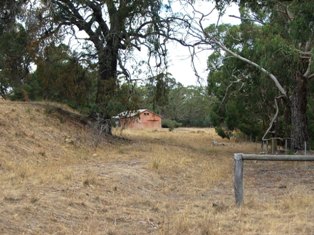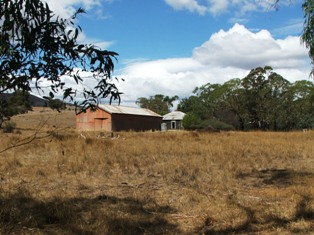
A view of the Company's loco shed from Major's Line Road, along the rail bed that led to the road and out into the forest. Kevin Crockett, 2015.

Another view of the loco shed with the derelict office behind. Kevin Crockett, 2015.
A private railway, it ran into the Moormbool Forest using road reserves where possible. Victorian Railways locomotives were permitted restricted distance access into the siding for the purpose of picking up trucks loaded with wood brought in from landowners' properties and the forest. The operation came to an end about 1927 after an unsuccessful attempt to sell it to the Victorian Railways.
The siding location exists on private property today.
Frank Stamford's book, "The McIvor Timber & Firewood Company, Tooborac, Victoria" published 2014 by Light Railway Research Society of Australia Inc, Melbourne, provides a very detailed acount of the Company's operation and it is recommended reading for anyone requiring that level of detail. I had commenced collecting information about the Company in the early days of this Collection but abandoned it as there was no need to re-invent the wheel. For my purposes, there is only a need to include some general information from the book.
Company details. That which can be seen today does not even hint at the size of the operation that once existed on the site. In its heyday, the site boasted a combined 6-roomed house and office building, a blacksmith's shop, a 21 ton railway weighbridge, stables, coal stage, and a 90' x 26' locomotive shed, and three sawmills with elevated platforms for loading small sawn blocks into wagons beneath. Two locomotives were generally used with one working their main (forest) line and the other working sidings deep in the forest.
Outwards tonnage slowly diminished over the years from a maximum of almost 60,000 tons in 1908, to around 25,000 tons in 1913, to around 10,000 tons in 1926, and the Company eventually reached the point of non-viability. Some of timber traffic at the north end of the forest was being 'syphoned off' by traffic carried on the Rushworth-Colbinabbin railway. In 1926, after the end of the Company's 15 year agreement with the MicIvor Shire, which was not renewed, local woodcutters, on becoming aware that the operation was about to close, campaigned for the Victorian Railways to purchase it. They were not successful and, like many railway-related operations, it passed into history.
Weekly Notice entries for McIvor Timber and Firewood Coy Siding:
March, 1906 - Staff Locks are provided to the main running line points. The Key is the Tooborac-Heathcote Train Staff.
June, 1906 - The siding is renamed McIvor Timber Coy's Siding.
July, 1934 - The siding is Out Of Use, disconnected, and the Staff Locks removed.
November, 1934 - The Shunter's gangways are removed from the bridge at 63M 39C 41L.

